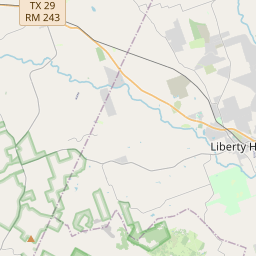Original Site of Southwestern University
Historical marker location:






The Methodist church established four colleges in Texas prior to the Civil War: Rutersville College (1840), Wesleyan College (1844), McKenzie Institute (1848), and Soule University (1856). The Rev. Dr. Francis Asbury Mood (1830-1884) was named president of Soule University in Washington County in 1868. Soon after he took office, plans were begun to relocate the school and develop a centralized Methodist university.
About the same time, city leaders in Georgetown began plans to establish a college. This site was donated for that purpose by John J. Dimmitt and G. W. Glasscock, Jr., and a community school, instead of a college, opened in 1870.
Georgetown was among the cities competing for the site of the planned Methodist university. In 1873 this property was chosen as the site of the new institution, which was granted a union charter (with the four earlier colleges) in 1875 as Southwestern University. Dr. Mood served as president until his death.
Buildings added to the campus after 1873 included a young ladies school, a chapel, a boys dormitory (Giddings Hall), and a gymnasium. Southwestern University moved to its present site in 1900 but continued to operate a preparatory department here until 1916
As one of the most visible programs of the Texas Historical Commission (THC), historical markers commemorate diverse topics in Texas history, including: the history and architecture of houses, commercial and public buildings, religious congregations, and military sites; events that changed the course of local and state history; and individuals who have made lasting contributions to the state, community organizations, and businesses.
The first domed stadium in the world, the Astrodome, was built in Houston in 1965 and hosted numerous sporting events and concerts over the years.
The region was first settled by European pioneers in the mid-19th century. The establishment of Fort Tumlinson in 1839 provided protection to settlers, and the population grew steadily with the arrival of more immigrants in search of new opportunities. In 1848, the county was officially organized and named after Robert McAlpin Williamson, a judge and soldier in the Republic of Texas.
During the Civil War, Williamson County faced significant challenges. Many residents joined the Confederate Army, and the county became a hotbed of conflict due to its location on the frontier between Union and Confederate territories. After the war, the area was able to rebuild and experienced a period of economic growth, driven by agriculture, cattle ranching, and the emergence of small towns and rural communities.
In the 20th century, Williamson County continued to develop and adapt to changing times. The discovery of oil in the early 1900s brought economic prosperity to the region, and the county experienced a boom in population and infrastructure. Today, Williamson County is a thriving part of the greater Austin metropolitan area, known for its strong economy, vibrant communities, and commitment to preserving its historical roots.
Williamson County Timeline
This timeline provides a condensed summary of the historical journey of Williamson County, Texas.
- 1804 - The area that is now Williamson County is settled by Native American tribes, including the Tonkawa, Lipan Apache, and Comanche.
- 1836 - Texas gains independence from Mexico.
- 1838 - The Texas legislature establishes Williamson County, named after Robert McAlpin Williamson, a leader in the fight for Texas independence.
- 1848 - The Mexican-American War ends and the Treaty of Guadalupe Hidalgo is signed, officially establishing the Rio Grande as the boundary between Texas and Mexico.
- 1850 - The population of the county reaches 1,027.
- 1876 - The Texas State Capitol building is completed in Austin, which becomes the seat of government for Williamson County.
- 1881 - The International-Great Northern Railroad reaches Georgetown, bringing economic growth and development to the county.
- 1907 - The county courthouse, located in Georgetown, is completed.
- 1930s - The Great Depression hits Williamson County, causing a decline in the local economy.
- 1950s - The county experiences a period of growth and prosperity, with the population increasing significantly.
- 1990s - Development and suburbanization accelerate in Williamson County, with the county becoming one of the fastest-growing areas in the United States.